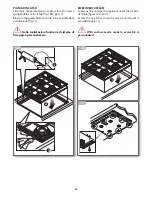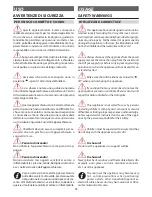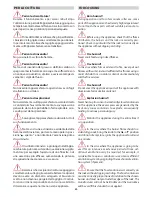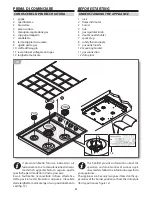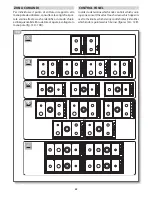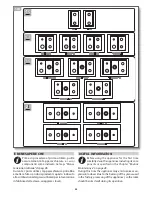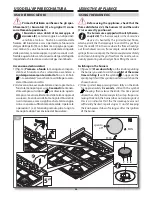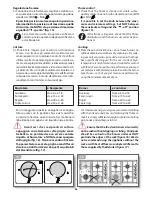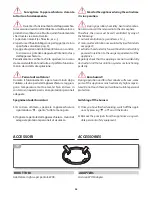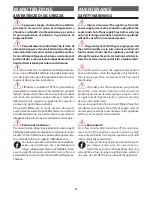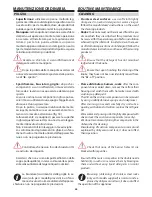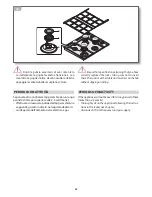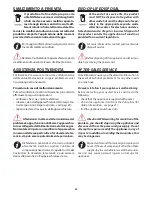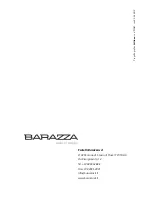
28
MANUTENZIONE ORDINARIA
PULIZIA
t
Superfici inox:
utilizzare un panno morbido leg-
germente imbevuto di detergente specifico neutro
o aceto caldo: per le modalità d’uso dei prodotti di
pulizia seguire le indicazioni del loro produttore.
t
Manopole:
le manopole non devono essere sfilate
dal perno sul quale sono montate, tale operazione
è riservata all’installatore per la regolazione del
minimo: per la loro pulizia utilizzare un panno
morbido appena imbevuto di detergente neutro
(per le modalità d’uso dei prodotti di pulizia seguire
le indicazioni del loro produttore).
Accertarsi che non ci siano infiltrazioni di
detergente sotto le manopole.
Dopo la pulizia delle manopole accertarsi di
non averle accidentalmente spostate dalla posizio-
ne di “ - spento” .
t
Spartifiamma, bruciatori, griglie:
dopo che i
componenti si sono raffreddati, rimuoverli dalla
loro sede e lavarli con acqua calda e detersivo per
i piatti.
Lo sporco ostinato sui componenti in ghisa può es-
sere rimosso utilizzando una spugna leggermente
abrasiva ed uno sgrassatore.
Dopo la pulizia, risciacquarli abbondantemente,
asciugarli con molta cura e successivamente rimon-
tarli con la massima attenzione
(fig. 18)
.
Saltuariamente si consiglia di passare le superfici
in ghisa (quando asciutte) con uno straccio legger-
mente imbevuto di olio di oliva.
Non è consentito il loro lavaggio in lavastoviglie.
Lo scolorimento degli elementi in ghisa è un feno-
meno dovuto al normale utilizzo dell’apparecchia-
tura e non ne pregiudica le prestazioni.
Controllare che nessun foro dei bruciatori (3)
sia ostruito da impurità.
Accertarsi che non vi siano impurità all’interno delle
coppe portaugello (6), in tal caso rimuoverle aspiran-
dole senza utilizzare detergenti liquidi o similari.
La brunitura (scurimento) delle griglie in ac-
ciaio (solo per i modelli provvisti) è un feno-
meno dovuto al normale utilizzo dell’apparec-
chiatura e non ne pregiudica le prestazioni.
ROUTINE MAINTENANCE
CLEANING
t
Stainless steel surfaces:
use a soft cloth lightly
dampened in neutral detergent or warm vinegar:
follow the manufacturer’s instructions on the use of
the cleaning products.
t
Knobs:
the knobs must not be removed from the piv-
ots on which they are attached: this procedure must
be reserved for the person responsible for installation
when setting the idle mode. In order to clean them, use
a soft cloth dampened in neutral detergent (follow the
manufacturer’s instructions on the use of the cleaning
products).
Ensure that the detergent has not remained
lodged under the knobs.
Ensure that upon finishing the cleaning of the
knobs, they have not been accidentally moved from
the “ - off” position.
t
Flame distributors, burners, racks:
after the com-
ponents have cooled down, remove them from their
housing and wash them with hot water mixed with
washing-up detergent.
The dirt on the cast iron components can be removed
by using a mildly abrasive sponge and a degreaser.
After cleaning, rinse well, carefully dry and subse-
quently, with utmost attention, replace them
(figure
18)
.
We recommend passing a cloth lightly dampened with
olive oil over the cast iron components (once dry).
We do not recommend placing the components in the
dishwasher for cleaning.
Discolouring of cast iron components is normal and
explained by daily wear and tear; it does not affect
their operation.
Check that none of the burner holes (3) are
blocked with impurities.
Ensure that there are no impurities in the double nozzle
holders (6), in such a case, remove them by blowing on
them and without using liquid detergents or similar
products.
Browning (darkening) of stainless steel racks
(only with models supplied) is normal and ex-
plained by daily wear and tear; it does not affect
the operation of the appliance.
Summary of Contents for PILB481CZI
Page 31: ......





